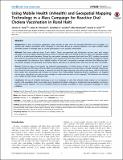| dc.contributor.author | Teng, Jessica E. | en_US |
| dc.contributor.author | Thomson, Dana R. | en_US |
| dc.contributor.author | Lascher, Jonathan S. | en_US |
| dc.contributor.author | Raymond, Max | en_US |
| dc.contributor.author | Ivers, Louise C. | en_US |
| dc.date.accessioned | 2014-09-08T15:37:32Z | |
| dc.date.issued | 2014 | en_US |
| dc.identifier.citation | Teng, Jessica E., Dana R. Thomson, Jonathan S. Lascher, Max Raymond, and Louise C. Ivers. 2014. “Using Mobile Health (mHealth) and Geospatial Mapping Technology in a Mass Campaign for Reactive Oral Cholera Vaccination in Rural Haiti.” PLoS Neglected Tropical Diseases 8 (7): e3050. doi:10.1371/journal.pntd.0003050. http://dx.doi.org/10.1371/journal.pntd.0003050. | en |
| dc.identifier.issn | 1935-2727 | en |
| dc.identifier.uri | http://nrs.harvard.edu/urn-3:HUL.InstRepos:12785952 | |
| dc.description.abstract | Background: In mass vaccination campaigns, large volumes of data must be managed efficiently and accurately. In a reactive oral cholera vaccination (OCV) campaign in rural Haiti during an ongoing epidemic, we used a mobile health (mHealth) system to manage data on 50,000 participants in two isolated communities. Methods: Data were collected using 7-inch tablets. Teams pre-registered and distributed vaccine cards with unique barcodes to vaccine-eligible residents during a census in February 2012. First stored on devices, data were uploaded nightly via Wi-fi to a web-hosted database. During the vaccination campaign between April and June 2012, residents presented their cards at vaccination posts and their barcodes were scanned. Vaccinee data from the census were pre-loaded on tablets to autopopulate the electronic form. Nightly analysis of the day's community coverage informed the following day's vaccination strategy. We generated case-finding reports allowing us to identify those who had not yet been vaccinated. Results: During 40 days of vaccination, we collected approximately 1.9 million pieces of data. A total of 45,417 people received at least one OCV dose; of those, 90.8% were documented to have received 2 doses. Though mHealth required up-front financial investment and training, it reduced the need for paper registries and manual data entry, which would have been costly, time-consuming, and is known to increase error. Using Global Positioning System coordinates, we mapped vaccine posts, population size, and vaccine coverage to understand the reach of the campaign. The hardware and software were usable by high school-educated staff. Conclusion: The use of mHealth technology in an OCV campaign in rural Haiti allowed timely creation of an electronic registry with population-level census data, and a targeted vaccination strategy in a dispersed rural population receiving a two-dose vaccine regimen. The use of mHealth should be strongly considered in mass vaccination campaigns in future initiatives. | en |
| dc.language.iso | en_US | en |
| dc.publisher | Public Library of Science | en |
| dc.relation.isversionof | doi:10.1371/journal.pntd.0003050 | en |
| dc.relation.hasversion | http://www.ncbi.nlm.nih.gov/pmc/articles/PMC4117440/pdf/ | en |
| dash.license | LAA | en_US |
| dc.subject | Biology and Life Sciences | en |
| dc.subject | Immunology | en |
| dc.subject | Vaccination and Immunization | en |
| dc.subject | Medicine and Health Sciences | en |
| dc.subject | Infectious Diseases | en |
| dc.subject | Bacterial Diseases | en |
| dc.subject | Infectious Disease Control | en |
| dc.subject | Public and Occupational Health | en |
| dc.subject | Behavioral and Social Aspects of Health | en |
| dc.subject | Global Health | en |
| dc.title | Using Mobile Health (mHealth) and Geospatial Mapping Technology in a Mass Campaign for Reactive Oral Cholera Vaccination in Rural Haiti | en |
| dc.type | Journal Article | en_US |
| dc.description.version | Version of Record | en |
| dc.relation.journal | PLoS Neglected Tropical Diseases | en |
| dash.depositing.author | Thomson, Dana R. | en_US |
| dc.date.available | 2014-09-08T15:37:32Z | |
| dc.identifier.doi | 10.1371/journal.pntd.0003050 | * |
| dash.contributor.affiliated | Thomson, Dana R. | |


